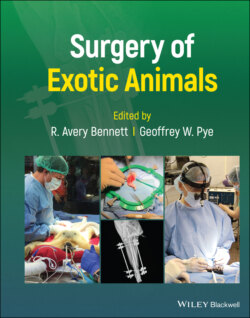Читать книгу Surgery of Exotic Animals - Группа авторов - Страница 126
Ophthalmic Surgery
ОглавлениеGiven the moist environment for aquatic amphibians, corneal ulcers can be difficult to treat as ophthalmic topical aqueous solutions and ointments are quickly diluted. Deep corneal ulcers may be treated with a tarsorrhaphy or with butyl cyanoacrylate tissue adhesive (Williams and Whitaker 1994). Tarsorrhaphy is performed in a similar manner as domestic animals.
Enucleation may be performed as a salvage procedure (Wright and Whitaker 2001a; Imai et al. 2009). Indications for enucleation are similar to those of other vertebrates and include nontreatable painful intraocular lesions and retro‐orbital neoplasms or abscesses (Williams and Whitaker 1994). Of note, amphibians have higher regenerative abilities than mammals and many anurans and newt are able to regenerate their retina while adult newts and African clawed frog tadpoles are able to regenerate their lenses (Filoni 2009). As a result, in patients with cataracts, removal of the lens allows the growth of a new transparent lens and retinal lesions that progress to permanent blindness in mammals may heal in amphibians. Temporary tarsorrhaphy may be performed to protect the cornea pending vision recovery.
Figure 6.6 An albino axolotl (Ambystoma mexicanum) presented with a traumatic amputation of the left forelimb (white arrow) and multifocal bite wound on the tail and left hind limb (black arrow). The left forelimb traumatic wound is left open to allow limb regeneration.
Source: Photo courtesy: Aquarium du Québec.
In species that retract their globe during food swallowing, the globe is very mobile and a gauze should be placed in the mouth prior to ocular surgery (Chai 2016). After infusion of local anesthetic into the conjunctival tissue, incise the conjunctiva and dissect the extraocular muscles from the globe, which frees the globe from its attachments. Take care to not damage the tissue between the orbit and the oral cavity (Wright and Whitaker 2001a) and to not damage the facial vein (Forzan et al. 2012). Transect the optic nerve and vessels and control hemorrhage with pressure using a cotton‐tipped applicator or by packing the orbit with a collagen sponge (OraPlug, Salvin, Charlotte, NC) or an absorbable gelatin hemostatic sponge. If using hemostats to clamp the retro‐orbital vessels, avoid putting traction on the optic chiasm that would cause blindness in the contralateral eye. Tarsorrhaphy with nylon suture material is recommended in species with eyelids to facilitate hemostasis (Wright and Whitaker 2001a) (Figure 6.7). Second intention healing is also an option (Chai 2016).
Lens excision has been described in a milk frog (Tachycephalus resinifictrix) (Chai 2016). Make a two‐step circumferential incision over 180° at the limbus with a keratome with the first incision perpendicular to the globe and then a second deeper incision with a more pronounced angulation to prevent the cornea from collapsing. Inject viscoelastic medium in the anterior chamber. Retrieve the lens with a Snellen loop. Irrigate with saline. Suture the cornea in one layer with 9‐0 nylon, in a simple interrupted pattern.
Figure 6.7 Enucleation of the right eye in an Oriental fire‐bellied toad (Bombina orientalis).
Source: Sepaq | Aquarium du Québec..
